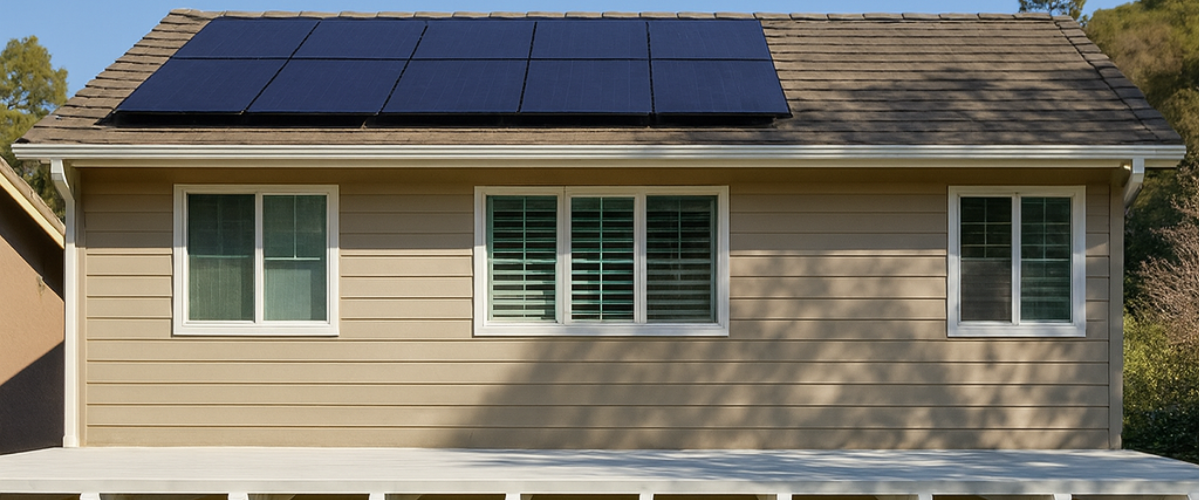Is Your Roof Suitable for Solar Panel Installation?

Solar and Roofing Advisor
Curious about solar panel installation on your roof? Learn about the key factors that determine suitability and unlock the potential of solar energy.

In today's world, the shift towards renewable energy is more important than ever. Solar energy stands out as a sustainable choice, but before you jump on the bandwagon, it's crucial to determine if your roof is suitable for solar panel installation. This comprehensive guide will walk you through the key considerations and help you make an informed decision.
Understanding Your Roof's Compatibility
1. Roof Type: What's the Best Roof Type for Solar Installation?
The type of roof you have plays a significant role in determining the feasibility of solar panel installation. Some roof types are more compatible than others. Here are the most common roof types:
Asphalt Shingle Roofs
Pros:
- Most common and solar-friendly roofing material
- Easy to work with for mounting equipment
- Affordable and quick to install
Cons:
- May wear out faster than solar panels (usually ~20 years lifespan)
- Older shingles may need replacement before solar installation
Tile Roofs (Clay or Concrete)
Pros:
- Durable and long-lasting (40–50+ years)
- Aesthetically pleasing and popular in California homes
- Compatible with solar with the right mounting hardware
Cons:
- Tiles can be fragile—may break during installation
- Installation requires specialized mounting brackets
- Higher labor cost due to complexity
Metal Roofs (Standing Seam)
Pros:
- Ideal for solar: panels can be clamped onto seams without drilling
- Very durable (up to 50+ years)
- Low maintenance and fire-resistant
Cons:
- Higher upfront roofing cost
- Less common in residential homes
Flat Roofs
Pros:
- Flexible panel positioning for optimal sunlight
- Easy access for maintenance
- Ideal for commercial and modern-style homes
Cons:
- Requires tilted racking system to maximize efficiency
- May have drainage or space limitations
Wood Shake Roofs
Pros:
- Traditional look with good insulation properties
Cons:
- Not ideal for solar—flammable and fragile
- Installation may be prohibited or require extra approvals
- Limited installer availability and higher cost
Pro Tip:
Before installing solar panels, ensure your roof is in good condition. It’s more cost-effective to repair or replace a roof before installation than to remove and reinstall panels later.
2. Assessing Roof Angle for Solar Panels
The angle of your roof affects the efficiency of solar panels. Ideally, solar panels should face south at an angle equal to the latitude of your location. However, most roofs are not perfectly angled. Here’s how to assess:
Ideal Roof Angle for Solar Efficiency
- Best angle = Your geographic latitude (e.g., Los Angeles ≈ 34°)
- Roofs with a 15°–40° pitch typically perform well without needing tilt adjustments
- South-facing roofs generate the most energy in the Northern Hemisphere
What If Your Roof Isn’t Perfectly Angled?
East- or West-facing roofs can still generate up to 85–95% of optimal output
Flat roofs can use adjustable tilt racks to achieve the right angle
Too steep or too shallow? Custom mounting systems can adjust panel angles
Why Roof Angle Matters
- Too steep: Reduces sun exposure, especially in winter
- Too flat: Can lead to water pooling and dirt accumulation
- Optimal tilt: Maximizes energy production throughout the day and across seasons
Pro Tip:
If your roof’s angle isn’t ideal, ground-mounted systems or tilt racks may be viable alternatives. A professional installer can calculate your exact solar potential using tools like sun path analysis and roof modeling.
3. Evaluating Roof Load Capacity for Solar Panels
Understanding the weight of solar panels on your roof is crucial. A typical solar panel weighs about 40 pounds, and the mounting hardware adds additional weight. Before installation, ensure that your roof can support this additional load:
How Much Do Solar Panels Weigh?
- A standard residential solar panel weighs 35–45 pounds
- A typical system adds about 2.5–4 pounds per square foot to your roof
- Mounting equipment and racking systems contribute additional load
Why Load Capacity Matters
Safety: Prevents structural stress or long-term damage
Building Code Compliance: Required for permits and inspections
Longevity: Ensures both the roof and the solar system last their full lifespan
What You Can Do
- Schedule a roof inspection with a structural engineer or qualified contractor
- Check for signs of aging or weakness, such as sagging, water damage, or loose shingles
- Reinforce the roof structure if necessary before solar installation
Ideal Conditions:
- Newer roofs with solid framing are typically ready for solar
- Flat or lightly sloped roofs often have higher load tolerance
- Tile or wood shake roofs may need reinforcement or special mounting
Pro Tip:
Many solar installers offer free roof assessments or partner with structural engineers to evaluate load capacity. Addressing any roofing issues before installation can save thousands in the long run.
Steps to Determine If Your Roof Is Solar-Ready
4. Conducting a Roof Inspection Before Solar Installation
A thorough inspection is a must before proceeding with solar panel installation on the roof. Here’s how to know if your roof is solar-ready:
What to Look for During a Roof Inspection
Age of the Roof
- Asphalt roofs older than 15–20 years may need replacement
- Tile and metal roofs typically last longer but still need inspection
Structural Integrity
- Check for sagging, cracks, or weak spots in the roof deck
- Ensure the roof can bear the added weight of solar equipment
Shingle or Surface Condition
- Look for curling, cracking, or missing shingles/tiles
- Watch for mold, water stains, or rot—signs of moisture damage
Flashing and Seals
- Inspect areas around vents, chimneys, and skylights
- Damaged flashing can lead to leaks under solar mounts
Why This Step Matters
- Prevents unnecessary costs down the road
- Ensures safety and long-term durability
- Required by most reputable solar installers before project approval
- May be part of local building code or permitting process
Pro Tip:
Ask your solar provider if they offer a free roof inspection as part of your consultation. It’s a smart move to address repairs before installing solar, saving time and avoiding disruption later.
5. Considerations for Shading and Orientation
Shading can significantly reduce the efficiency of solar panels. Ensure your roof receives adequate sunlight:
Why Sunlight Matters
Solar panels need direct sunlight to produce energy efficiently. Shadows from trees, chimneys, neighboring buildings, or even roof structures (like dormers or satellite dishes) can cause:
- Reduced daily output
- Inconsistent energy production
- Decreased return on investment
Ideal Panel Orientation
- In the Northern Hemisphere, panels perform best when facing true south
- Southeast and southwest-facing roofs are also effective and often acceptable
- Flat roofs allow for flexible tilt and orientation using mounting racks
How to Minimize Shading Issues
- Trim overhanging trees or vegetation that block sunlight
- Avoid placing panels near tall roof obstructions
- Use microinverters or power optimizers to minimize shading impact on the entire system
- Request a shade analysis from your solar consultant (often done using tools like solar pathfinders or drone-based assessments)
Pro Tip:
Shading is most problematic between 10 AM and 3 PM, when solar generation should peak. If your roof receives full sun during these hours, you're in excellent shape for solar installation.
US Power Is Your Reliable Solar and Roofing Advisor
Determining whether your roof is suitable for solar panel installation involves assessing various factors such as roof type, angle, load capacity, and shading. A thorough inspection and professional consultation can provide the clarity you need. Once your roof is deemed suitable, you can proceed with confidence, knowing you're making a sustainable choice for your home and the planet.
Ready to make the switch to solar? Contact US Power, a leading energy solutions provider, for expert guidance and installation services.
Embrace the power of the sun and start your journey towards a greener future today!
Frequently Asked Questions
Related Articles
Our Related Blogs
Uncover the best solar brands in Los Angeles, California built for long-term value.
Compare QCells and REC panels to pick the right solar option for your home.
Finish your stalled solar project fast with US Power + QCells’ factory-direct panels.








We empower communities and businesses to harness clean, renewable solar energy solutions that drive sustainable growth.
Ready to Own Your Power? Call us today!
818-650-8010
Copyright © 2025 US Power - Axia by QCells. All Rights Reserved.
Privacy is important to us, so you have the option of disabling certain types of storage that may not be necessary for the basic functioning of the website. Blocking categories may impact your experience on the website.
Essential
These items are required to enable basic website functionality.
Personalization
These items allow the website to remember choices you make (such as your user name, language, or the region you are in) and provide enhanced, more personal features.
Marketing
These items are used to deliver advertising that is more relevant to you and your interests.
Analytics
These items help the website operator understand how its website performs, how visitors interact with the site, and whether there may be technical issues.
We and our third-party partners use cookies and other technologies to enhance and track your experience on this site, conduct analytics, and personalize marketing to you. By using the site, you agree to our use of these technologies, including recording and monitoring your interactions with the site.
Get an instant solar estimate using satellite!









